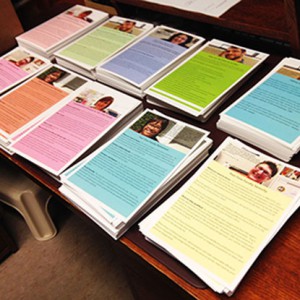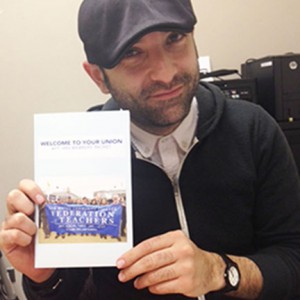San Mateo Community College Federation of Teachers, AFT 1493
Minutes of General Membership/Executive Committee Meeting
Wednesday, December 10, 2014, at CSM
EC members present: Eric Brenner, Vicki Clinton, Salumeh Eslamieh, Stephen Fredricks, Katharine Harer, Teeka James, Dan Kaplan (Exec. Secr.), Michelle Kern, Doniella Maher, Monica Malamud, Sandi Raeber-Dorsett, Joaquin Rivera, Paul Rueckhaus, Shaye Sahedi, Janice Sapigao, Anne Stafford, Elizabeth Terzakis, Rob Williams.
AFT (non-EC) members present: Jessica Silver-Sharp (PT Librarian @ Skyline)
Meeting began at 2:30 p.m. in closed session
Facilitator: Anne Stafford
Wecome and Introductions
Done.
Statements from AFT (non EC) members on Non-Agenda Items
None.
Minutes of November 12, 2014 AFT meeting
Approved unanimously.
New Resource Allocation Model – Kathy Blackwood
The current Resource Allocation Model has been in place for ten years. Kathy Blackwood distributed a handout showing what the allocations may look like under our existing model, with the changes that have been made to it. The following notes are intended as comments/clarification for the handout, not as a complete stand-alone explanation of the New Resource Allocation Model.
Step 1: based on enrollment growth, an additional allocation would have been made to a college experiencing growth.
FTES is not a very good measure of how we serve students. Since we’re not currently funded based on enrollment, the emphasis of enrollment is now being diminished.
Since all three colleges need to have a basic staffing structure, regardless of size, the idea is to have a Site Allocation that is not tied to the number of students. To account for this, there is a one time increase in the Site Allocation for Canada.
Step 2: Central Services
Utilities and retiree benefits are the two largest items. There will be an increase based on inflation. District has no control over these costs.
Step 3: Facilities
There’s an increase in the Facilities Allocation when there is an increase in square footage.
Step 4: Growth
Allocate growth based on 5-year increase/decrease in FTES (this used to be based on a 3-year period).
Step 5: District Office and Facilities
Allocate growth to District Office and Facilities as a % of growth allocation to colleges.
Step 6:
District costs for step and column – colleges get from the District the amount that is needed by each site.
CPI on non personnel allocation—this is new.
Demonstrated Need — $3Mill allocated for this new item.
It’s for innovative projects. The College Presidents would present their needs to the Chancellor’s Cabinet, using forms that are being developed. Individual College decides how to allocate money, and which projects to fund. Colleges would need to submit evaluation of the project. If it’s working, then they get to roll this into the college’s budget. In addition to the colleges, both the District Office and Facilities may apply for these funds.
Step 7: Allocate any remaining funds across the board.
At the EC’s request, Kathy also talked about the Proposed Reserves Policy
Board requested Kathy to make changes to reserve policy and increase reserves. She used information from the GFOA (Government Financial Officers Association). Recommend no less than two months’ worth of reserves. Average ending balance has been 18.8% (in 2011) to a low of around 2.9%.
What are our risk factors? Change in law, natural disasters, lower interest rates, economic improvement which results in lower CC enrollments.
For the proposed Reserves Policy, Kathy used the City of Atherton’s Policy as a model, which consists of three “buckets”:
Budget stabilization: to avoid mid-year cuts or having to make decisions in the summer
Emergency Disaster: for example, an earthquake
Working Capital: money needed every day
DAS asked Kathy to write a procedure for getting to the 15% reserve level. DAS suggested that reserves not be increased in years when there is not money to increase allocations to the colleges based on the new proposed budget allocation.
Finally, Eric asked about administrative hires in recent years. Kathy is working on a report.
Negotiations update — Joaquin
Medical benefits
AFT presented a modified proposal to the District consisting of:
i)Medical cap for FT:
$50 for singles
$125 for two-party
$175 for family
District’s response: will not move from their initial position of $50/75/100
ii)Medical reimbursement for PT:
$1200/semester
District’s response: District would agree to PT reimbursement of $800
One year MOU on faculty teaching assignments and administrators’ option to teach
Faculty may request in writing the reasons why they didn’t get their preferred teaching assignment.
Administrators: limit to one administrator per year per college
PT employment:
AFT has been trying to improve contract language. The only improvement that District will agree to is posting seniority lists in division offices.
Katharine said that the newly-hired FT faculty that she’s been talking with feel very connected with the PT, since they many were PT just before being FT. Michelle shared that more PT may be using the medical reimbursement going forward, given the obligation to sign up for ACA.
AFT is planning on doing a rallying up faculty, both PT and FT, for a campaign to fight for increases in medical benefits.
Strategic Campaign Initiative Organizing Project update – Michelle and Katharine
One challenge for Michelle has been scheduling time to meet with PT, because of the PT’s schedule.
COPE fund: Katharine has gotten 10 new COPE members. We were getting $63/month, but now it’s up to $163/month.
There are extra packages, T-shirts and tote bags in the AFT office.
CSM Student Withdrawal Survey — Teeka
Teeka shared a survey that CSM conducted some years ago to find out why students withdrew from online courses. The survey was developed by the Research office, a VP, an Academic Dean, Enrollment Services Dean, and AFT President (Teeka) and DAS President (Diana) were invited to provide input. CSM faculty agreed to do this survey on the condition that no teachers would be identified; this agreement seems to have been honored and there have not been any negative repercusions. The District would like to adopt this survey district-wide.
Janice suggested including the option for the student to identify him/herself, to allow for follow-up.
DSGC Report
Tabled.
Release time: what are the criteria?
What is the expected workload for FT faculty? What portion of FT load is non-instructional? What kinds of duties should get release time?
This is a complex topic, and perhaps the EC will schedule a special focus meeting to discuss this topic at length.
AFT 1493 Resolution to Improve PT Pay Equity
Dan informed the EC that our Board has unanimously passed a version of the resolution. Dan has also taken the resolution to DAS, and they will put in on their next agenda.
Motion to support resolution: passed unanimously.
CFT Convention
Teeka talked about nominations for awards.
Higher Education Campaign Coalition
There is an attempt to put together a higher ed coalition: CFA (CSU union), CFT, AFSCME, etc. This coalition is trying to get the state budget more money for PT pay parity, paid office hours.
Adjourned at 5:03 p.m.

 A new District Board of Trustees policy has been proposed that would set “the appropriate level of reserves that the District will strive to maintain in its Unrestricted General Fund” at 15-30% of the District’s annual Unrestricted Gen
A new District Board of Trustees policy has been proposed that would set “the appropriate level of reserves that the District will strive to maintain in its Unrestricted General Fund” at 15-30% of the District’s annual Unrestricted Gen








